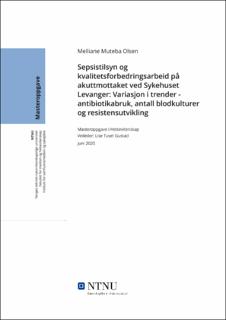| dc.contributor.advisor | Gustad, Lise Tuset | |
| dc.contributor.advisor | Gjeilo, Kari Hanne | |
| dc.contributor.author | Olsen, Melliane Muteba | |
| dc.date.accessioned | 2021-09-25T16:19:55Z | |
| dc.date.available | 2021-09-25T16:19:55Z | |
| dc.date.issued | 2020 | |
| dc.identifier | no.ntnu:inspera:47076024:23138385 | |
| dc.identifier.uri | https://hdl.handle.net/11250/2782774 | |
| dc.description.abstract | Bakgrunn: Sepsis er en alvorlig infeksjon som forårsaker 12% av alle dødsfall i norske sykehus. Sepsis skyldes at mikroorganismer kommer over i blodbanen og utløser en overdreven immunreaksjon. Dette kan gi organsvikt. Internasjonale og nasjonale retningslinjer for antibiotikabruk i sykehus anbefaler at antibiotikabehandling gis innen en time ved mistanke om sepsis. Helsetilsynet har gjennomført landsomfattende tilsyn, «Sepsis - ingen tid å miste» på somatiske akuttmottak, og Sykehuset Levanger fikk avvik på blant annet tid til antibiotikagiving til septiske pasienter. Det overordnede målet med denne masterstudien var å beskrive variasjon over tid i antibiotikaforsyninger, blodkulturer og resistensutvikling i etterkant av tilsyn og deltakelse i læringsnettverk for tidlig oppdagelse og behandling av sepsis ved Sykehuset levanger. Masterprosjektet hadde som delmål å beskrive: (1) forsyning av intravenøs antibiotika som brukes ved sepsisbehandling per infeksjonspasient innlagt i akuttmottaket ved Sykehuset Levanger, herunder andel av smalspektret og bredspektret antibiotika, (2) antall og andel blodkulturer tatt på innlagte infeksjonspasienter ved Sykehuset Levanger, (3) utvikling av resistens på Sykehuset Levanger for de antibiotikatypene som brukes i sepsisbehandling.
Metode: Det ble gjennomført retrospektiv og deskriptiv analyse av data fra tidsperiode 01.09.2015-31.12.2018. Data ble hentet fra akuttdatabasen (pasienter innlagt med kontaktårsak alvorlig infeksjon), Sykehusapoteket (antibiotikaforsyning) og mikrobiologisk laboratorium (blodkulturer).
Resultat: Det ble registrert totalt 4404 pasientinnleggelser med kontaktårsak alvorlig infeksjon og pasienttallet holdt seg stabilt i perioden. Forsyningen av antibiotika økte med 113% fra første tilsynsperiode til fjerde tilsynsperiode. Blodkulturer tatt i observasjonsperioden økte med 24%, mens andelen positive blodkulturer holdt seg stabilt på 3.9%. Resistensutvikling mot de ulike typer antibiotika var stabilt.
Konklusjon: Antibiotikaforsyningen til akuttmottaket økte, og økningen kunne ikke forklares med økning i pasientinnleggelser. Antall blodkulturer tatt var også stigende uten at dette økte andel positive blodkulturer. Selv om resistensen var stabil, kan resultatene samlet tyde på behov for en gjennomgang av om antibiotika ble gitt på riktige pasienter. En slik fremtidig studie kan være grunnlag for å utarbeide forslag for å optimalisere bruk av antibiotika i akuttmottak. | |
| dc.description.abstract | Introduction: Sepsis is a serious infection that accounts for 12% of all of hospital mortality in Norway. Sepsis occurs when microorganisms enter the bloodstream and trigger an immune response as a defense mechanism. This may cause organ failure. The international and national Guidelines for the use of antibiotics in the hospitals recommend administration of antibiotics within one hour if sepsis is suspected. The National Board of Health (Helsetilsynet) carried out a nationwide inspection “Sepsis – no time to lose” at somatic Emergency Departments, and Levanger Hospital had deviations from procedure, including too long time from identification of sepsis to administration of antibiotics. The overall objective of this master study was to describe the variation over time in the supply of antibiotics, blood cultures and resistance development following the inspection and participation in learning program for early detection and treatment of sepsis at Levanger Hospital. This master study has the aims to describe: (1) supply of intravenous antibiotics that is used in the sepsis treatment per infection patient admitted to the Emergency Department at Levanger Hospital, including the proportion of narrow-spectrum and broad-spectrum antibiotics, (2) the amount and proportion of blood cultures taken on the hospitalized patients at Levanger Hospital, (3) The development of resistance at Levanger Hospital for the antibiotic types recommended in sepsis treatment.
Method: Retrospective and descriptive analysis of data from period 01.09.2015-31.12.2018. Data were obtained from the Emergency Department (Patient with severe infection), the Hospital pharmacy (antibiotic supply) and microbiological laboratory (blood cultures).
Result: 4404 patients with severe infections were recorded. The supply of antibiotics increased by 113% from the first period of inspection to the fourth period. The blood culture taken during the observation period increased by 24%. Resistance to the various types of antibiotics has been stable.
Conclusion: The antibiotic supply to the Emergency Department increased, and the increase could not be explained by the increase in patient admissions. The number of blood culture taken was also increasing without the proportion of positive blood cultures increased. Although the resistance was stable, the overall results may indicate a need for a review of whether antibiotics were given to the right patient. Such a future study may be the basis for making suggestion on how to optimize the use of antibiotics in the Emergency Department. | |
| dc.language | | |
| dc.publisher | NTNU | |
| dc.title | Sepsistilsyn og kvalitetsforbedringsarbeid på akuttmottaket ved Sykehuset Levanger: Variasjon i trender - antibiotikabruk, antall blodkulturer og resistensutvikling | |
| dc.type | Master thesis | |
